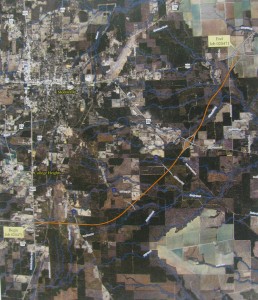AHTD Hearing Tuesday Answers Most Questions about Monticello Bypass for I-69
September 9th, 2009 by Joe BurgessThe Arkansas State Highway and Transportation Department held a Public Hearing Tuesday evening at the Sadie Johnson Community Center, to allow public input, as well as answer some questions about the proposed plans for a bypass of Monticello for the future I-69.
 Approximately 90 area residents attended the informational meeting, to ask questions about their land, houses, and community. I was able to go through the process of question and answers with a couple who are losing their home of 12 years to the new roadway, as they visited with one of the approximately 9 AHTD representatives who were present for the forum, representing different departments of the AHTD.
Approximately 90 area residents attended the informational meeting, to ask questions about their land, houses, and community. I was able to go through the process of question and answers with a couple who are losing their home of 12 years to the new roadway, as they visited with one of the approximately 9 AHTD representatives who were present for the forum, representing different departments of the AHTD.
 The official name of the “Monticello Bypass” is known as “job 020471”, and will begin near the “dead man’s curve” area of HWY 278 East, and continue to it’s end, on HWY 425 South, near the Drew Central Bus Shop.
The official name of the “Monticello Bypass” is known as “job 020471”, and will begin near the “dead man’s curve” area of HWY 278 East, and continue to it’s end, on HWY 425 South, near the Drew Central Bus Shop.
AHTD brought to the meeting 3 16 foot long maps, showing in great detail the exact area, down to storage sheds, that will be directly affected by the construction.
Interchanges will be built at the 278 East and HWY 425 connection points, as well as it’s crossing with HWY 35 South/HWY 35 East.
3 overpasses will be built where the new roadway comes into the Old Deane Road, Old Troy Road, and Midway Route areas of construction.
The 8.6 mile project will also be raised over the crossing of the Arkansas Midland Railroad.
The project could begin as early as acquiring properties with the next year, and beginning the bid process for construction in the Fall of 2010. The project will begin as a 2 lane highway, and will be expanded into a 4 lane divided roadway in the future.
After the bid process begins, it will be an estimated 2 years of grading and clearing, followed by approximately 2 years of paving, to bring the roadway to 2 lane highway status.
The primary question on the minds of Drew Countians was, “When”, but the state officials were not able to give any specific answers to schedule any potential transactions by.
—————
The acquisition of right-of-way involves the property owners being contacted by different individuals from the AHTD Right-of-Way Division. These may include appraisers, negotiators, closing agents and possibly property managers.
The initial step in the acquisition process is the property valuation. Once the evaluation is prepared, reviewed and approved, a negotiator will contact the property owner by mail or in person to begin the negotiation process. If negotiations are successful, a Contract to Sell is executed and submitted for payment. Once the AHTD completes the title opinion and the deed is prepared, a closing agent will be in touch to get the deed signed and deliver the check. At this time, the state takes possession of the property. It is possible that if a “former home-owner” hasn’t relocated, that they may then be in a position to pay rent to the state, to live in their residence, until permanent housing can be found.
An AHTD spokesperson emphasized, “we can’t put you in something less than what you already have.” The process is designed to work better for displaced residents who will be buying a replacment home, than for those who desire to re-build.
For those cases where all efforts to negotiate are unsuccessful, the tract is submitted to the AHTD Legal Division to file for the property’s condemnation. The appraisal amount is deposited in the court and the landowner may withdraw the funds placed on deposit without affecting their right to claim additional compensation.
No one will be required to surrender possession of their property or improvement until just compensation has been made. A detailed policy and procedures brochure is available at the Right-of-Way through the AHTD Right-of-Way Division.
The first contact will likely be made by the appraisers, who will be determining “fair market value.”
——————-
The relocation assistance program is intended to help offset expenses incurred by homeowners who are displaced by highway projects.
No one can be required to move without at least ninety (90) days advance written notice, and comparable replacement housing will be made available to all residential displacees (built if necessary) before construction begins on the project.
Relocation assistance, which is separate from the compensation a person receives for real estate, comes in two basic forms — physical and financial assistance. In order to be eligible for relocation assistance and compensation, a person must live in the property when the negotiations for the property begin.
Relocation assistance brochures which explain each payment and each eligibility requirement in detail are available from AHTD.
Other forms of financial assistance that can be provided to citizens who are relocated include help with closing costs of their new home, and assistance in offsetting changes in interests rates that may have changed since their original purchase.
————-
The Environmental Assessment was prepared and approved by the Federal Highway Administration in August 2005, and did not identify any significant impact to the natural and social environment.
The information presented at the hearing is the best indication of what the Arkansas State Highway and Transportation Department is proposing at this time.
———————–
The Arkansas Highway & Transportation Dept. can be contacted by calling our local AHTD residential engineer at 367-5095, or stopping by their office, located at 1932 HWY 425 North, just past Cablevision.
Choose another article
Newer article: MES Staff Member Arrested on Drug Charges by DTF
Older article: Arrest at R&R Festival, 2nd Year in a Row




























































